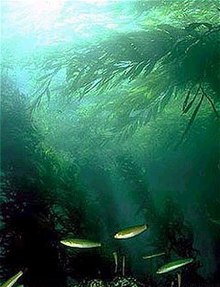This is an old revision of this page, as edited by WarthogDemon (talk | contribs) at 02:53, 17 November 2006 (rvv). The present address (URL) is a permanent link to this revision, which may differ significantly from the current revision.
Revision as of 02:53, 17 November 2006 by WarthogDemon (talk | contribs) (rvv)(diff) ← Previous revision | Latest revision (diff) | Newer revision → (diff)
| Kelp | |
|---|---|

| |
| Californian kelp forest | |
| Scientific classification | |
| Kingdom: | Protista |
| Division: | Heterokontophyta |
| Class: | Phaeophyceae |
| Order: | Laminariales Migula |
| Families | |
|
Alariaceae | |
Kelp are large seaweeds (algae), belonging to the brown algae and classified in the order Laminariales. Despite their appearance they are not grouped with the normal aquatic or land plants (kingdom Plantae), but instead are included in either kingdom Protista or Chromista. There are about 30 different genera. Some larger members of the order Fucales are also included by some within the general term Kelp. Kelp grows in underwater forests (kelp forests) in clear, shallow, oceans, requiring nutrient rich water below about 20 °C, it offers a protection to some sea creatures, or food for others. It is known for its high growth rate - the genus Macrocystis grows up to 30 cm per day, to a total length of over 60 meters.
Morphology
In most Kelp the thallus (or body), consists of flat or leaf-like structures known as blades. Blades originate from elongate, stem-like structures, the stipes. These kelp are mainly purple or pink and consist of a methane gas that helps fish live. The holdfast, a root-like structure anchors the Kelp to the substrate of the ocean. Gas-filled bladders (pneumatocysts) form at the base of most blades and keep the Kelp blades close to the surface.
Uses
Bongo Kelp ash is rich in iodine and alkali. In great amount, kelp ash can be used in soap and glass production. Until the Leblanc process was invented, buring of Kelp was one of the principal industrial sources of Sodium carbonate. Alginate, a kelp-derived carbohydrate, is used to thicken products such as ice cream, jelly, salad dressing, and toothpaste, as well as in manufactured goods.
Prominent species
- bull-head kelp (Nereocystis luetkeana), a northwestern American species. Used by coastal indigenous peoples to create fishing nets.
- giant kelp (Macrocystis pyrifera), the largest seaweed. Found in the Pacific coast of North America and South America.
- kombu (Laminaria japonica), an edible species of kelp found in Japan.
Species of the British Isles
- Laminaria digitata (Hudson) J.V. Lamouroux (Oarweed; Tangle)
- Laminaria hyperborea (Gunnerus) Foslie (Curvie)
- Laminaria ochroleuca Bachelot de la Pylaie
- Laminaria saccharina (Linnaeus) J.V.Lamouroux (Sea Belt; Sugar Kelp; Sugarwack)

Species of Laminaris World-wide
- Laminaria agardhii (NE. America)
- Laminaria angustata (Japan)
- Laminaria bongardina Postels et Ruprecht (Bering Sea to California)
- Laminaria cuneifolia (NE. America)
- Laminaria dentigera Klellm. (California - America)
- Laminaria digitata (NE. America)
- Laminaria ephemera Setchell (Sitka, Alaska, to Monterey County, California - America)
- Laminaria farlowii Setchell (Santa Cruz, California, to Baja California - America)
- Laminaria groenlandica (NE. America)
- Laminaria japonica (Japan)
- Laminaria longicruris (NE. America)
- Laminaria nigripes (NE. America)
- Laminaria ontermedia (NE. America)
- Laminaria pallida Greville ex J.Agardh (South Africa)
- Laminaria platymeris (NE. America)
- Laminaria saccharina (Linnaeus) Lamouroux (Aleutian Islands, Alaska to southern California America)
- Laminaria setchellii Silva (Aleutian Islands, Alaska to Baja California America)
- Laminaria sinclairii (Harvey ex Hooker f. ex Harvey) Farlow, Anderson et Eaton (Hope Island, British Coluumbia to Los Angeles, California - America)
- Laminaria solidungula (NE. America)
- Laminaria stenophylla (NE. America)
Other genera in the Laminariales which may be considered as "Kelp".
- Alaria marginata Post. & Rupr. (Alaska and California - America
- Costaria costata (C.Ag.) Saunders Japan; Alaska, California - Amertica)
- Durvillaea potatorum (Labillardière) Areschoug (Tasmania; Australia)
- Ecklonia brevipes J.Agardh (Australia; New Zealand)
- Ecklonia maxima (Osbeck) Papenfuss (South Africa)
- Ecklonia radiata (C.Agardh) J.Agardh (Australia; Tasmania; New Zealand; South Africa)
- Eisena arborea Aresch. (Vancouver Island, British Columbia, Montrey, Santa Catalina Island, California - America)
- Egregia menziesii (Turn.) Aresch.
- Hedophyllum sessile (C.Ag.) Setch (Alaska, California - America)
- Macrocystis angustifolia Bory (Australia; Tasmania and South Africa)
- Pleurophycus gardneri Setch. & Saund. (Alaska, California - America)
- Pterygophora californica Rupr. (Vancouver Island, British Columbia to Bahia del Ropsario, Baja Californis and California - America)
Interactions
Some animals are named after the kelp, either because they inhabit the same habitat as kelp or because they feed on kelp. These include:
- Kelp crab (Pugettia producta), the Pacific coast of North America.
- Kelpfish (blenny) (e.g., Heterosticbus rostratus, genus Gibbonsia), the Pacific coast of North America.
- Kelp Goose (kelp hen) (Ocydromus fuscus), South America and the Falkland Islands
- kelp pigeon (sheathbill) (Chionis sp), Antarctic
See also
- Kelp forest
- bladder wrack
- KeLP programing system
- Monterey Bay Aquarium, which displays a kelp forest and its wildlife.
- Underwater Seaweed Video
- Kyle Saunders